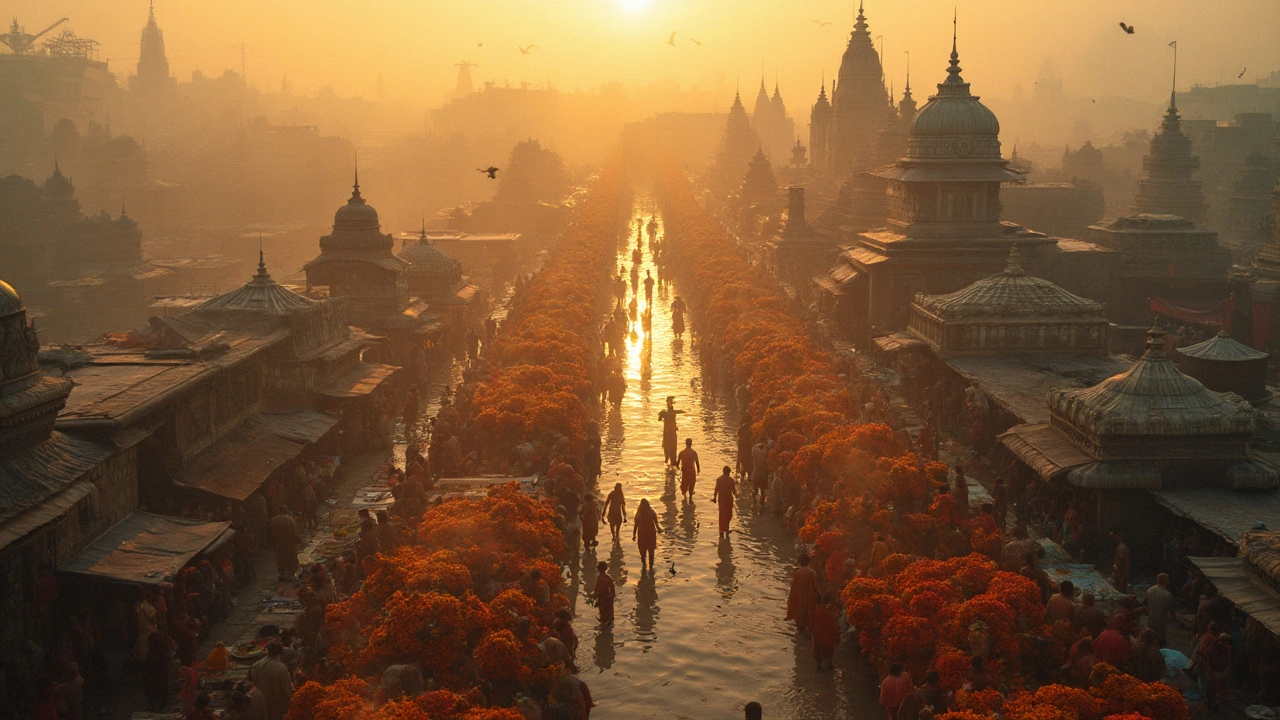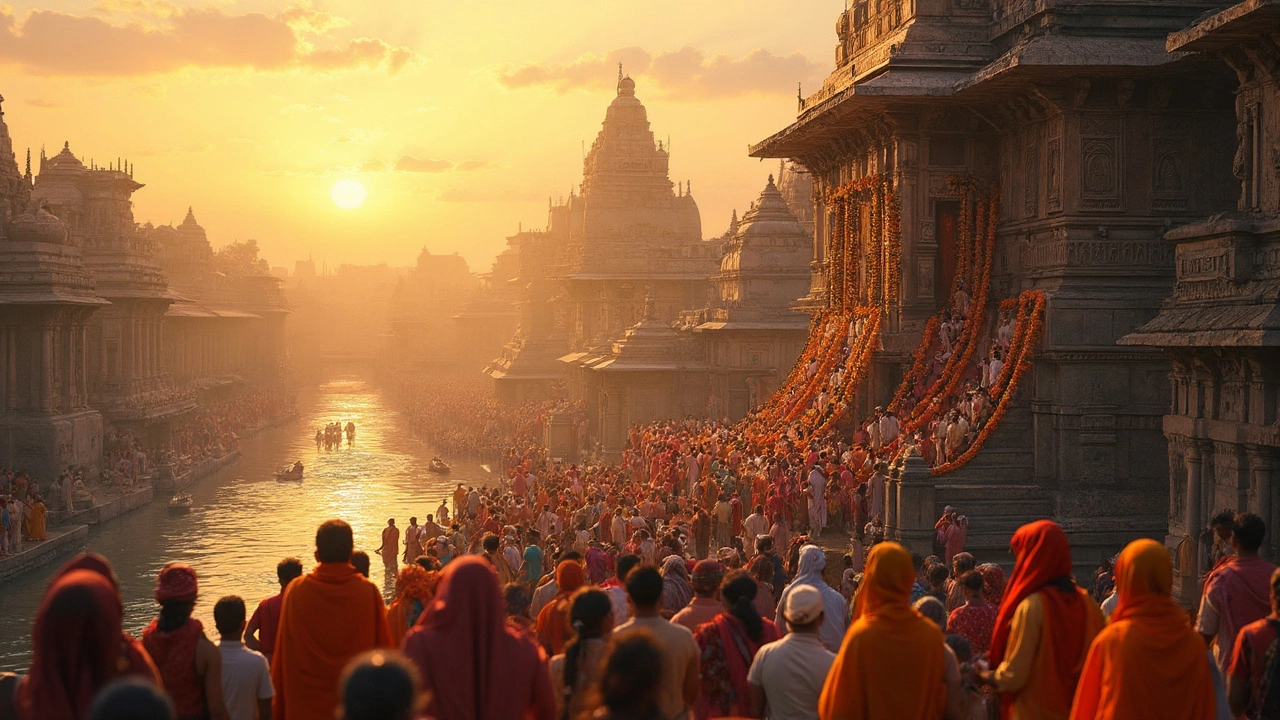If you've ever been caught up in an argument about the holiest temple in India, you're not alone. The answer isn't as simple as you might think, and trust me, people get passionate about it. Everyone's got an opinion—your grandma might swear by Tirupati, your neighbor roots for Kedarnath, and half the cab drivers in Delhi drop the name Varanasi before you can finish your question.
But here's the thing: what even makes a temple "holier" than the rest? It's not always about size, age, or even foot traffic. Sometimes it's about myths swirling around it, the traditions held tight for centuries, and how locals and pilgrims treat the land under their feet. You want to know where India's spiritual pulse really throbs? It's more than a checklist item on a tour—it's about energy, legacy, and belief packed into one single spot. If you're planning a temple tour and want more than just pretty photos, stick around as we unpack what sets India's holiest temple apart from the rest, and how to actually experience its magic for yourself.
- What Makes a Temple the Holiest?
- Varanasi’s Kashi Vishwanath Temple: The Spiritual Powerhouse
- Beyond the Obvious: Contenders for the Title
- Insider Tips for Your Holy Temple Tour
What Makes a Temple the Holiest?
So, what really puts a temple at the top of the list? It’s not just old stones and gold roofs. In India, a temple gets the “holiest” badge from a mix of stories, ancient texts, hard-core devotion, and the sheer number of yearly visitors. And we’re not talking about a couple thousand people—the holiest temple in India has lines of pilgrims that sometimes seem to stretch across cities.
Here’s what gives a temple its clout:
- Historical Legends: Temples tied to major Hindu legends get special attention. If the site is linked to gods like Shiva, Vishnu, or Devi, that’s a serious plus. Kashi Vishwanath, for example, is believed to be where Shiva lives eternally—big deal in the Indian spirituality world.
- Mentions in Scriptures: If a temple is praised or even just mentioned in epic texts like the Vedas, Ramayana, or Mahabharata, its status shoots up. Priests often recite these lines to highlight a temple's importance during rituals.
- Pilgrimage Status: Official “must-visit” stops on the Hindu pilgrimage trail, known as the Char Dham or Jyotirlingas, are automatic spiritual powerhouses. You’ll see thousands—sometimes millions—making the journey every single year.
- Unbroken Traditions: The ones that never skip a festival or ritual, where generations have prayed the same way, earn that enduring trust and following.
- Community Buzz: If people around the area tell you, “This is the holiest temple,” chances are, the spot has deep roots in the local and national psyche.
If you look at top temples across the country, you’ll spot these patterns. Here’s a quick look at some numbers to drive the point home:
| Temple | Annual Pilgrims (approx.) | Associated Deity |
|---|---|---|
| Kashi Vishwanath (Varanasi) | 20 million | Shiva |
| Tirupati Balaji | 30 million | Vishnu |
| Golden Temple (Amritsar) | 10 million | Sikh Guru Granth Sahib |
| Kedarnath | 1.5 million | Shiva |
But here’s the clincher: Holiness is also personal. People travel the country chasing that feeling in temple tours, and the answer to which is the holiest often depends on your faith, your family, and your own story. Still, there’s always a shortlist, and one temple tends to come up more than the rest. Ready to see which one?
Varanasi’s Kashi Vishwanath Temple: The Spiritual Powerhouse
If you ask people about the holiest temple in India, Kashi Vishwanath in Varanasi usually gets top marks. It sits right by the Ganges, in the heart of a city that claims to be older than history itself. The temple is dedicated to Lord Shiva—the destroyer and creator rolled into one—and is part of the famous twelve Jyotirlingas, making it a go-to for serious pilgrims. Locals believe a visit here unlocks blessings not just for this life, but your next one, too.
Here’s why this temple matters so much:
- Ancient Roots: The current structure was rebuilt in 1780 by Ahilyabai Holkar, but temples at this spot trace back thousands of years. Mughal invasions saw the temple destroyed more than once, but it kept coming back.
- Location, Location, Location: Set right in the "spiritual capital of India," Kashi is what Varanasi was called when legends started buzzing. The Ganges river next door only adds to the vibe—many people believe dying here leads straight to liberation from the endless cycle of birth and death.
- Cultural Magnet: Every year, millions line up—sometimes for hours or even overnight—just to catch a glimpse of the Shiva Lingam. During festivals like Maha Shivaratri, the crowd honestly feels endless.
- No Temple Without a Story: There are tales of hidden gold, invaders, secret passages, and even an underground shaft that once protected the main idol from destruction. No boring moments here.
If stats interest you, here’s some quick data:
| Yearly Pilgrims | Distance from Varanasi Railway Station | Peak Festival |
|---|---|---|
| About 7 million | ~5 km | Maha Shivaratri |
Don’t expect an easy in-and-out visit. You’ll face security checks, long lines, and tight spaces. Phones and cameras aren’t allowed inside. Best trick? Book a slot early (online if possible), come in light clothing, and skip heavy bags. The “Vishwanath Gali” lane leading up to the temple packs a punch, with street food, rudraksha shops, and the wildest street action you’ll see. If you’re planning a temple tour in India for the real experience, Kashi Vishwanath is a solid must.

Beyond the Obvious: Contenders for the Title
When folks ask about the holiest temple in India, the usual answers get tossed out—Kashi Vishwanath, Tirupati, Kedarnath, and Jagannath Puri almost always pop up. Each packs serious spiritual energy, but what actually pushes them closer to the top of the list? Let's break down a few of the heavy hitters and what gives them their legendary buzz.
- Tirupati Balaji Temple (Tirumala, Andhra Pradesh): Hands down, it's the busiest temple in the world. Tirupati sees up to 50,000 people daily and over 30 million pilgrims every year. It’s not just about numbers though; the temple’s stories of miracles and wealth (they auction devotees’ hair for charity!) make it a hot spot for anyone chasing blessings.
- Kedarnath Temple (Uttarakhand): Sitting high in the Himalayas, Kedarnath isn’t exactly easy to get to. But that’s part of the draw. Pilgrims believe the trek washes away years of bad karma. Every season, folks risk tough weather for a glimpse of the ancient Shiva lingam that’s said to be over a thousand years old.
- Jagannath Temple (Puri, Odisha): The famous Rath Yatra event draws millions—so much so that the whole town feels like it’s vibrating. Even non-Hindus can feel the pull of the energy here. Fun fact: the temple’s kitchen is the biggest in the world, serving 100,000 meals on the busiest days.
- Golden Temple (Amritsar, Punjab): While it’s technically a Sikh gurudwara, the Golden Temple is jaw-dropping on both a spiritual and architectural level. Over 100,000 visitors drop by daily. Its shimmering gold leaf and the sense of calm by the sacred lake are legendary.
Choosing the holiest spot means weighing all of these stories, facts, and experiences. Check out what a historian from the Indian Ministry of Culture says:
"No single temple holds all the spiritual cards. What makes a place holy is what you bring to it and the sense of community around it."
If you’re looking for a truly spiritual India experience, you won’t go wrong with any of these big names. Pilgrims often line up for hours, sleep on the floor, and plan their yearly vacations around these temple cities. The best part? Each temple adds a unique twist to the idea of holiness—so you get a completely different vibe every time you visit a new one.
| Temple | Annual Visitors | Location |
|---|---|---|
| Tirupati Balaji | 30 Million+ | Andhra Pradesh |
| Kedarnath | 1 Million+ | Uttarakhand |
| Jagannath Puri | 2.5 Million (Rath Yatra) | Odisha |
| Golden Temple | 35 Million | Punjab |
When you’re sketching out your temple tours India bucket list, don’t just stick to the headline spots. Sometimes, the lesser-known shrines tucked away in mountain corners or hidden alleys have just as much soul—without the crowds. But if you want to walk paths millions have walked before you, these big four give you stories to tell for a lifetime.
Insider Tips for Your Holy Temple Tour
So you want your trip to the holiest temple in India to go smoothly—no missed rituals, no getting lost, no rookie mistakes? Read on for the details that other guides gloss over.
First off, timing is everything. The Kashi Vishwanath Temple in Varanasi, for example, sees huge crowds during festivals like Maha Shivaratri or Kartik Purnima, with over a million visitors pouring in on peak days. If you want a more peaceful experience, aim for early mornings—most temples open to pilgrims as early as 3:00 or 4:00 am.
- Leave shoes and electronics: Security is strict at holy sites like Kashi Vishwanath. Leave your phone, camera, and shoes at designated counters—they won't let you inside with them.
- Dress code: Most sacred temples expect modest clothing. For men, that usually means full-length pants, and for women, consider a sari or salwar kameez. Cover your head if you see locals doing the same—just follow the crowd.
- Offerings and pooja: At major temples, official counters sell puja supplies (flowers, milk, offerings) near the entrance. Avoid pushy street vendors outside; their prices are usually much higher.
- Pocket some small cash: While entry tickets are often affordable (in Varanasi, basic darshan is free, but special access can cost ₹300-₹500), you'll need small bills for tips and donations.
- Respect the ritual flow: During aarti ceremonies, follow instructions and don't push ahead for photos or a better view. The temple staff are serious about crowd control, especially in hot months when tempers run high.
Here's a handy breakdown if you're targeting top pilgrimage spots on your temple tours:
| Temple | Daily Visitors (Avg.) | Main Festival |
|---|---|---|
| Kashi Vishwanath (Varanasi) | 60,000+ | Maha Shivaratri |
| Tirupati Balaji | 75,000+ | Brahmotsavam |
| Kedarnath | 12,000 (seasonal) | Opening Day Yatra |
Feeling overwhelmed? Apps like "Tirth" or "Templo" can help you navigate routes, get darshan times, and even book special access in advance so you're not stuck in a three-hour line.
One more thing most visitors don’t realize: Varanasi's old city alleys are a maze. GPS sometimes fails there, so map out your walk or hire a local guide for a few bucks—it’ll save you frustration and help you avoid those monkeys who love stealing unattended bags.
Get ready to walk a lot and stand in lines. Hydrate, wear comfortable shoes (until the entrance!), and keep your plans flexible. Chasing spiritual bliss on your Indian pilgrimage isn’t about rushing from one landmark to another—it’s about soaking up the vibe, talking to fellow pilgrims, and maybe, catching that early-morning chant that gives you goosebumps. That’s the real magic.
